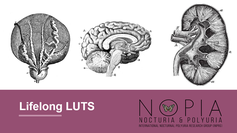Nopia - Nocturia & Polyuria
Introduction
Nopia is a genus of moth in the family Geometridae. They appear rather butterfly-like but in most respects, they are typical moths: they fly at night, they possess a frenulum to link the wings, and the antennae of the males are often feathered.
The name NOPIA research group reflects this nocturnal waking up and activities as well as the first letters of nocturnal polyuria and the last letters of nocturia.
Nocturia is the most prevalent and bothersome symptom of the lower urinary tract resulting in loss of quality of life and morbidity and mortality.
The NOPIA group was founded in 2011 and studies lower urinary tract symptoms (LUTS) throughout our lives and is mainly focusing on clinical research. Our main aim is to improve healthcare and care for patients with lower urinary tract symptoms through research, publications, PhDs, and the creation of evidence-based guidelines.
Research group members
Karel Everaert, François Hervé*, Ann Raes, Johan Vande Walle, Lien Dossche*, An-Sofie Goessaert*, Marie-Astrid Denys*, Kristian Juul Vinter*, Jeff Weiss*, Veerle Decalf*, Tove Holm Larsen, Ann Vanhecke, Jens peter Norgaard, Mirko Petrovic, Herman Depypere, Dirk Vogelaers, An Mariman, Don Bliwise, Wendy Bower, Alan Wein, Paul Abrams, Piet Hoebeke, Erik Van Laecke, Dirk Vande Putte, Dudley Robinson, Salvator Arlandis, Upeksha Alwis*, Kim Pauwaert*, Annick Viaene*, Tine Kold Olesen*, Thomas Monaghan*, Nico De Witte, Jos Schols, Dimitri Beeckman.
*Former PhDs from the NOPIA research group
3 NOPIA Research Domains:
1) Nocturia and nocturnal polyuria
The study of nocturnal LUTS and circadian rhythms of bladder, kidney, and sleep. So far we focused on the bladder and kidneys but today we study the impact of the cardiovascular system and sleep on nocturia and nocturnal polyuria. As the most bothered group are older people we further focus on how to diagnose and treat them.
- researchers: Rebecca Haddad, Jason Lazar, Irina Verbakel, Sevasti Karamaria
- funding: Frederik Paulsen Chair (Ferring)
2) Lifelong LUTS
Our nocturia research focused on circadian rhythms and we quickly realized how important transition phases in life are in impacting symptoms related to the bladder, the kidney and sleep. We further realized how transition phases affected our diagnosis and therapeutic thinking in patients with enuresis or nocturia and we wondered if this concept can be mirrored in LUTS in general and OAB in specific.
Based on the previous diagnostic, pathophysiological, and therapeutic advances, the concept of lifelong overactive bladder emerges, opening the discussion on its etiological and pathological bases, and the consequence of its implementation in a management scheme that considers effective long-term treatments.
- researchers: George Bou Kheir, Mauro Vanden Ende, Rebecca Haddad, Anja Huion
- funding: Ferring, Astellas, Medtronic, HoGent
3) Sacral Neuromodulation and the role of Specialized Nurses in functional Urology
We aim to substantiate our hypothesis that the evaluation of pelvic floor symptoms in a more holistic way could enhance the assessment of the test phase of sacral neuromodulation, surpassing the traditional approach of discipline-specific symptom evaluation alone. Furthermore, we want to study "Integration of Nurse Practitioners in healthCARE settings in Flanders (NP-Care): Nurse practitioner-sensitive outcomes for evaluation and unraveling implementation processes focusing on sacral neuromodulation".
- researchers: Lynn Ghijselings, Sofie Everaert, George Bou Kheir
- funding: OptiLuts Medtronic Chair, Medtronic, Ghent University hospital

